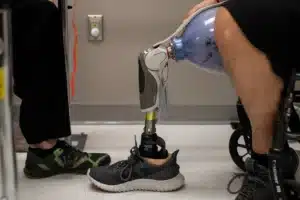Written by Edgar Sandoval for The New York Times. Reprinted with permission.
A lethal combination of genetics, poor access to health care and diets high in processed foods is fueling a diabetes crisis in Latino communities, especially in Texas.

©Kaylee Greenlee for The New York Times
At a medical facility on the west side of San Antonio, the patients show up with disturbing regularity — most of them men. They have sores on their feet that won’t go away. And they leave with the same devastating news: Their diabetes has progressed to the point that their leg must be amputated to save their lives.
Diabetes has been on the rise around the world, and Latino communities in the United States have been especially hard hit. A lethal combination of genetics, poor access to health care, diets high in processed foods and sedentary lifestyles has created a crisis in places like San Antonio, a majority Mexican American city in Southern Texas, that is costing a growing number of men their feet and legs — and eventually, for some, their lives.
Texas has one of the highest rates in the nation for people undergoing diabetes-related amputations, at about 52 per 100,000 hospital admissions. The problem in San Antonio is even worse than in the rest of Texas, especially for men, who are roughly three times more likely to lose a foot or leg to diabetes than women — possibly because of cultural stigmas that prevent many Latino men from looking closely after their health.
“It’s a huge issue in San Antonio and dare I say, it’s the diabetic foot capital of the world, in terms of complications,” said Michael Sobolevsky, a podiatry doctor at the Texas Diabetes Institute, the facility run by University Health in the heavily Latino neighborhoods of western San Antonio. “We are constantly amputating.”
The disease is also killing at an alarming rate. Bexar County’s mortality rate for diabetes exceeds that of the rest of Texas and the country as a whole, according to data from the Centers for Disease Control and Prevention that was analyzed by the city’s health department.
Type 2 diabetes, the most common type of the disease, occurs when the body becomes unable to keep blood sugar at normal levels. It affects many parts of the body, but often notably the feet, which may have to be amputated when blood supply fails to reach the lower extremities over extended periods, leading to serious infections that turn to gangrene.
That’s why Dr. Sobolevsky warns his patients to take even the slightest sores on their feet seriously. “My job is to prevent, save, save, save.

©Kaylee Greenlee for The New York Times
The problem was evident to Ralph DeFronzo, who played a key role in the development of metformin, the first-line medication for treatment of diabetes, almost as soon as he arrived in San Antonio in the late 1990s. He said he fell in love with the colorful and welcoming Mexican American culture and city landmarks like the Alamo and the River Walk.
But troubling health patterns became evident to him right away. Even as a young doctor, he knew that Latinos and Native Americans have genes that predispose the pancreas to make insufficient insulin, and other genes that cause tissues to resist it. He also knew that San Antonio’s much-celebrated Tex-Mex cuisine — which often is high in fatty oils and red meat, and includes things like flour tortillas and sweets that are high in processed carbohydrates — can wreak havoc on a body.
A recent city report noted that more than 76 percent of the adult population in the San Antonio area, or more than a million adults, are considered obese or overweight.
“Here in San Antonio, if you actually went and tested all of the people, you would find that probably one in every two individuals over the age of 40 has diabetes,” Dr. DeFronzo said.
Dr. DeFronzo said the diabetes center where he first worked was run out of a basement, “literally a dungeon,” a signal to him that the problem was not being addressed with sufficient urgency. The practice moved gradually to the first floor, then the second. “I finally convinced the hospital district that the biggest problem in San Antonio is diabetes,” he said.
In 1999, the Texas Diabetes Institute opened as an expansive facility on the city’s West Side, a historically Mexican American neighborhood that, along with the city’s southern neighborhoods, has had fewer medical facilities than wealthier sections of town, an analysis by the San Antonio Express-News found.
It is also an area of town where the cost of health care can be an issue. Republicans in Texas have consistently opposed expanding Medicaid for low-income residents under the Affordable Health Care Act of 2013. A recent study by Texas 2036, a think tank, found that more than 16 percent of the state’s population, or 5 million people, do not have health insurance.
“If Texas expanded Medicaid, we’d see fewer amputations,” said Joaquin Castro, a congressman who represents San Antonio. “It’s that simple.”

©Kaylee Greenlee for The New York Times
The diabetes institute now handles about 80,000 patients a year, offering all facets of diabetes care, including research, diagnosis and treatment, dietary education, physical therapy — and amputations. Its walls are decorated with drawings of feet and legs, a constant reminder of the dangers that await if sores on diabetic limbs are left untreated.
The institute has particularly tried to focus on the disproportionate effects of the disease on men, and increasingly, on boys. In a one-year period, boys under 18 saw a 36 percent increase in hospitalizations linked to diabetes, twice the rate of increase for girls.
Julius Hunter, a program coordinator with San Antonio’s Diabetes Prevention and Control program, said some of that can be attributed to culture: Males, he said, are programmed from an early age to “tough it out,” and tend to ignore cuts and lesions that may be a telltale sign of serious diabetes problems, even after being told they have the disease. The city’s various diabetes seminars are attended almost exclusively by women, Mr. Hunter said.
“‘Are you a man or are you going to cry like a little boy?’ Those messages carry all the way to adulthood, especially for men of color,” Mr. Hunter said.
So the city’s health department started up The Diabetes Garage, a program modeled after one in El Paso, which consists of a series of workshops utilizing car maintenance metaphors where men can ask questions in a familiar environment and learn how to properly maintain their bodies.
The crisis has even touched some of the city’s political leaders. A grandmother of Mr. Castro, the congressman, lost a leg to diabetes and eventually succumbed to the disease. “For Hispanics in South Texas, diabetes is the big boogeyman you’re always watching out for, especially if you can’t afford preventive care,” Mr. Castro said.
Robert Perez, 39, a Grammy-winning musician and recording engineer who has worked with Tejano superstars like Bobby Pulido and the band Siggno, never thought a Type 2 diabetes diagnosis four years ago was going to cost him his right leg. But then a year ago, the skin on his right pinkie toe broke open while he was carrying heavy music equipment, and it quickly became infected.
By the next morning, he said, much of his foot had turned purple, a sign that gangrene was setting in. At a nearby emergency room, he said, doctors delivered the news: Give up the foot, or die.
“Do whatever you have to do,” he told them.
Mr. Perez, known as Anthony Perez in the music industry, arrived at the diabetes institute one recent day to try out a new prosthetic leg. Strapping it onto his right thigh, he slowly rose from his wheelchair. His body shook. It had been more than a year since he had stood on two legs, he said.
Sensing some hesitation, Bryan Rumsey, a specialist in prosthetics and orthotics, encouraged him with lyrics from a Christmas song. “Put one foot in front of the other, and soon you’ll be walking across the floor,” he said.
Mr. Perez, who has slimmed down to 240 pounds from the 340 pounds he was before, moved his healthy leg first, followed ever so delicately by his new metallic limb. He caught a glimpse of himself upright on a large mirror and flashed a shy smile. “I’m learning to walk for the first time since I was a baby,” he said.
Moments later in the parking lot, a niece, Mikayla Sanchez, 31, winced as she watched him hop into the passenger side of her truck on his own. “I’m very excited for him, but also very nervous,” Ms. Sanchez said. “I don’t want him to fall.”
Juan Arguello III, 50, who has lived with a right-leg prosthetic for nearly three years, now helps train new patients like Mr. Perez how to use one. He calls his patients “the kids,” because they tend to be much younger than him.
“You take your leg off and show them how to put it on and learn to live with it,” he said.
One of his recent patients, he said, was a child of about 8. “That kind of destroyed me,” he said.
For Mr. Perez, the new limb meant he could get back on the road as a musician.
On New Year’s Eve, he walked onstage and played bass guitar for a gig in Midland, Texas. “I was able to stand and play for the first time in a long time,” he said. But he also knew: “I have a lot of steps ahead of me.”

